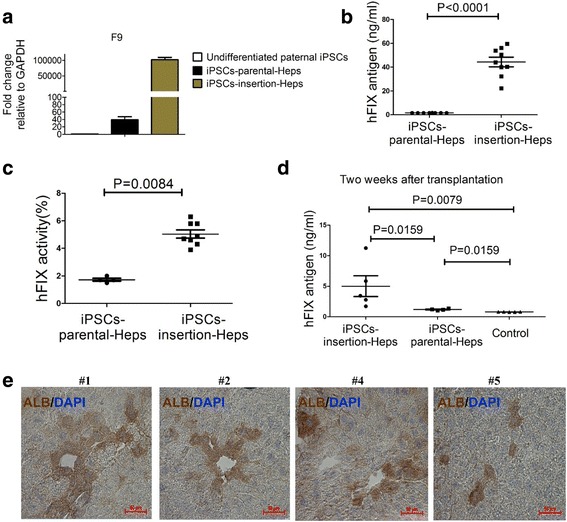Fig. 5.

Comparison of F9 expression, and hFIX antigen levels and activity between iPSC-parental-Heps and iPSC-insertion-Heps. a qRT-PCR showed F9 expression in undifferentiated iPSCs, iPSC-parental-Heps, and iPSC-insertion-Heps (n = 3 independent experiments for each sample). b Comparison of hFIX antigen levels in cell culture supernatant between iPSC-parental-Heps and iPSC-insertion-Heps. Student’s t test used. Data shown are mean ± SEM (n = 8 in iPSC-parental-Heps group, n = 9 in iPSC-insertion-Heps group). c Comparison of hFIX activity in cell culture supernatant between iPSC-parental-Heps and iPSC-insertion-Heps. Student’s t test used. Data shown are mean ± SEM (n = 4 in iPSC-parental-Heps group, n = 8 in iPSC-insertion-Heps group). d Two weeks after transplantation, hFIX antigen levels in mice plasma of the iPSC-insertion-Heps group, iPSC-parental-Heps group, and control group detected by ELISA. Student’s t test used. Data shown are mean ± SEM (n = 5 in iPSC-insertion-Heps group and the control group, n = 4 in iPSC-parental-Heps group). e Two weeks after transplantation, human ALB was detected in mice #1, #2, #4, and #5 of the iPSC-insertion-Heps group by immunohistochemistry. All scale bars represent 50 μm. GAPDH glyceraldehyde 3-phosphate dehydrogenase, iPSC induced pluripotent cell, hFIX human factor IX, DAPI 4′,6-diamidino-2-phenylindole, ALB albumin
